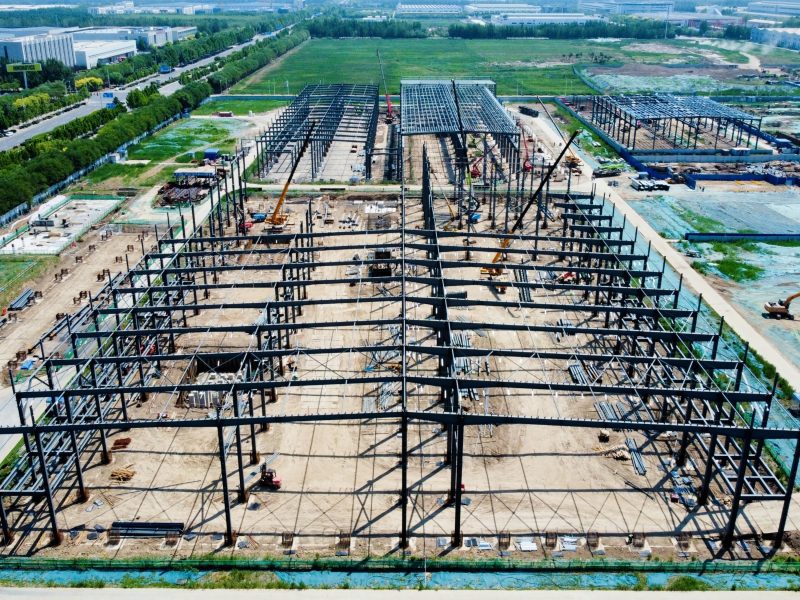
Advanced Modular Pig Housing: Enhancing Efficiency and Biosecurity for Modern Farms
Modern pig farming faces unprecedented challenges: rising operational costs, increasing demand for high-quality pork, and stricter biosecurity requirements. Traditional pig housing often struggles to meet these standards due to slow construction, high maintenance, and limited flexibility.
Advanced modular pig housing provides a forward-thinking solution. By integrating prefabricated steel structures, optimized layouts, and hygienic design, these systems allow farms to operate more efficiently, expand easily, and maintain strict biosecurity protocols.
This article explores how modular pig housing benefits commercial swine farms, highlighting design strategies, operational advantages, and real-world applications.
What Makes Modular Pig Housing Different?
Unlike conventional pigsties made of brick, wood, or concrete, modular pig housing uses prefabricated components assembled on-site. Key features include:
- Steel Frames: Provide structural durability and resistance to pests, rot, and fire.
- Insulated Panels: Maintain stable internal temperatures for all seasons.
- Pre-engineered Modules: Allow easy expansion or relocation without halting operations.
- Optimized Ventilation Systems: Ensure proper airflow to reduce disease risk.
- Smooth, Non-porous Surfaces: Facilitate cleaning and disinfection.
The result is a highly adaptable, long-lasting, and low-maintenance housing system tailored to modern farming demands.
Key Advantages of Advanced Modular Pig Housing
- Enhanced Biosecurity
Modular units reduce disease transmission risks with controlled ventilation, seamless surfaces, and compartmentalized pens. - Faster Deployment
Prefabrication allows installation in weeks, reducing downtime and accelerating farm productivity. - Operational Flexibility
Modular layouts can accommodate different pig categories—piglets, growers, and sows—with adjustable pen configurations. - Cost-Effective Maintenance
Durable materials and easy-to-clean surfaces reduce labor and long-term maintenance expenses. - Scalable Design
Farms can add modules incrementally, matching herd growth without major disruptions. - Sustainable Construction
Steel components are recyclable, and prefabrication minimizes material waste. Energy-efficient panels reduce heating and cooling costs. - Improved Animal Welfare
Adequate space, ventilation, and temperature control contribute to healthier, more productive pigs.
Design Considerations for B2B Clients
When adopting modular pig housing, commercial clients should evaluate:
- Pen Dimensions: Space must allow free movement and social interaction while maintaining hygiene.
- Feeding and Water Systems: Integrated designs improve labor efficiency and ensure easy access for all pigs.
- Climate Control: Incorporate automated fans, misting, or heating systems for optimal growth conditions.
- Waste Management: Sloped floors, drainage, and removable manure trays simplify cleaning.
- Future Expansion: Design modules for horizontal or vertical growth without operational downtime.
Applications Across Commercial Swine Farms
Advanced modular pig housing suits various operations:
- Large-Scale Meat Production Farms: Maintain efficient feeding and housing systems for high-density herds.
- Breeding Operations: Customizable pens for sows, boars, and piglets with integrated isolation areas.
- Research and Veterinary Farms: Controlled environments for clinical studies or disease monitoring.
- Organic and Specialty Farms: Adjustable layouts supporting natural ventilation and welfare standards.
Case Studies
- Commercial Farm Expansion (Europe):
Modular pig housing enabled a 40% increase in herd size without interrupting daily operations. Integrated ventilation and automated feeders improved growth rates. - Breeding Facility Upgrade (USA):
Prefabricated modules replaced aging wooden pigsties. Construction was completed in four weeks, reducing labor and improving biosecurity. - Organic Farm (Australia):
Modular housing units incorporated natural airflow and insulated panels, providing healthy, stress-free environments for pigs.
Why B2B Clients Should Invest in Modular Pig Housing
For B2B swine operations, modular pig housing offers:
- Speed: Faster setup and operational readiness.
- Durability: Long-lasting steel construction reduces repair costs.
- Flexibility: Easily reconfigured modules accommodate herd changes.
- Efficiency: Streamlined cleaning, feeding, and waste management save labor.
- Animal Welfare: Optimized environments enhance growth, health, and productivity.
- Sustainability: Recyclable materials and energy-efficient panels support environmentally responsible farming.
Investing in advanced modular pig housing ensures scalable, hygienic, and cost-effective operations, making it a strategic choice for modern commercial swine farms.
Conclusion
Modular pig housing is reshaping commercial swine farming by combining speed, flexibility, and hygiene. Prefabricated steel modules, optimized layouts, and integrated ventilation systems allow farms to scale efficiently while maintaining high standards of animal welfare.
For B2B clients, modular pig housing is a sustainable, cost-effective, and strategic solution that meets the demands of modern pig farming. B2B clients, investing in modular pigsties is a strategic solution that meets the demands of modern swine operations.
